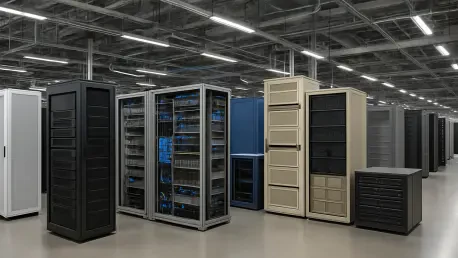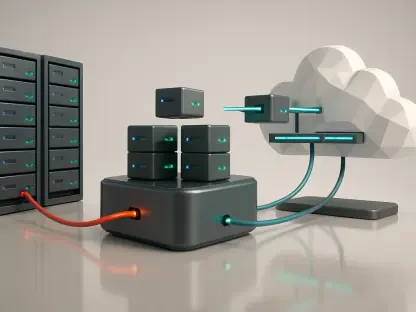In an era where data centers power everything from streaming services to artificial intelligence, the quest for efficiency and scalability has never been more critical, with hyperscale environments processing billions of transactions daily under immense pressure to optimize resources. Google has taken a bold step to address this challenge by integrating both x86 and Arm-based Axion processors into its production clusters, marking a seismic shift in cloud computing paradigms. This review dives deep into the intricacies of Google’s multi-architecture strategy, exploring how this transition is redefining hardware neutrality and setting a new benchmark for the tech industry.
Unveiling Google’s Multi-Architecture Vision
Google’s adoption of a multi-architecture framework, combining traditional x86 systems with Arm-based Axion processors, represents a significant departure from the long-standing reliance on a single architecture in data centers. This strategic pivot enables the company to run workloads across diverse hardware platforms, ensuring flexibility in deployment and optimization. By embracing this approach, Google challenges the status quo, paving the way for a more adaptable infrastructure capable of meeting varied computational demands.
The move away from x86 dominance underscores a broader trend toward hardware neutrality, where applications are designed to operate seamlessly regardless of the underlying architecture. This shift is particularly relevant as data center needs evolve, with increasing demands for energy efficiency and cost-effective scaling. Google’s initiative aligns with the industry’s growing recognition that no single architecture can address all modern computing challenges effectively.
Beyond internal benefits, this transition mirrors a wider movement within the tech sector, where architectural diversity is becoming a cornerstone of innovation. Cloud providers and enterprises alike are exploring heterogeneous environments to maximize performance and minimize operational costs. Google’s leadership in this space highlights the potential for multi-architecture systems to become a standard in hyperscale computing.
Core Elements of the Multi-Architecture Shift
Arm-Based Axion Processors: Breaking New Ground
At the heart of Google’s multi-architecture strategy lies the introduction of Arm-based Axion CPUs, designed to diversify the hardware ecosystem within its clusters. These processors prioritize energy efficiency and cost-effectiveness, offering a compelling alternative to traditional x86 systems. Their architecture focuses on delivering high performance per watt, addressing the critical need for sustainable computing in large-scale environments.
Performance metrics suggest that Axion processors provide notable advantages in terms of operational expenditure and power consumption compared to their x86 counterparts. While exact figures remain proprietary, the implied benefits include reduced energy costs and improved resource utilization, critical factors for hyperscale operators. This positions Arm as a viable contender for workloads previously dominated by x86 architectures.
The significance of Axion CPUs extends to enabling hardware-neutral application deployment, allowing developers to write code without targeting a specific architecture. This flexibility reduces dependency on any single hardware platform, fostering innovation and adaptability. Google’s investment in Arm technology signals a transformative step toward a more inclusive computing landscape.
Automation Through CogniPort AI Tool
Facilitating this massive architectural shift is CogniPort, an advanced three-agent AI system developed by Google to automate the migration of over 30,000 applications to Arm architecture. This tool tackles the complexities of transitioning workloads by identifying and resolving build and test failures autonomously. Its role is pivotal in managing the scale of such an extensive project without compromising service reliability.
Early testing of CogniPort revealed a 30% success rate in addressing migration issues, a promising start with room for refinement. The system comprises an orchestrator, a build-fixer, and a test-fixer, working collaboratively to streamline the porting process. This automation reduces manual intervention, accelerating deployment timelines and minimizing errors in production environments.
The importance of CogniPort cannot be overstated, as it addresses the inherent challenges of managing vast application portfolios during architectural transitions. By automating critical tasks, the tool ensures stability and consistency across platforms, a necessity for maintaining uptime in services with global reach. Its continued evolution will likely shape future migration strategies across the industry.
Latest Developments and Sector Trends
Google’s migration strategy has seen significant advancements, particularly through the adoption of modern compiler and sanitizer tools to overcome technical obstacles. These innovations help resolve discrepancies in code behavior across architectures, ensuring smoother transitions for complex workloads. Such progress reflects a commitment to refining the multi-architecture approach for long-term scalability.
Industry-wide, the embrace of Arm architecture is gaining momentum, with major cloud providers like AWS leveraging Graviton chips and Microsoft developing custom Arm solutions. This trend underscores a collective shift toward hardware diversity as a means to enhance data center efficiency. The competitive landscape is evolving, with architectural flexibility emerging as a key differentiator among hyperscalers.
The push for diverse hardware platforms also fosters a culture of optimization, where providers can tailor infrastructure to specific workload requirements. This adaptability not only improves performance but also drives down costs, benefiting end users through more affordable services. Google’s pioneering efforts are catalyzing a broader transformation, encouraging others to explore multi-architecture solutions.
Real-World Deployment and Broader Implications
Google has successfully deployed flagship services such as YouTube, Gmail, and BigQuery across both x86 and Arm-based systems, demonstrating the practical viability of its multi-architecture framework. These high-traffic applications operate seamlessly, proving that architectural diversity does not compromise performance or user experience. Such real-world implementations highlight the robustness of the strategy.
Specific use cases, including the migration of critical databases like F1, Spanner, and Bigtable, further illustrate the manageability of architectural challenges. Initial concerns about compatibility and performance were addressed through existing tools and meticulous planning, ensuring continuity for mission-critical systems. These successes validate the approach for other complex workloads.
The broader impact on cloud computing is profound, with potential cost savings and improved resource utilization reshaping hyperscale environments. By balancing workloads across architectures, providers can optimize infrastructure for efficiency, passing benefits to customers through competitive pricing. Google’s achievements signal a future where multi-architecture setups could become the norm, influencing global data center strategies.
Obstacles and Continuous Improvements
Despite the progress, Google’s migration journey has encountered technical hurdles, including architectural drift and performance inconsistencies across platforms. Platform-specific issues have occasionally disrupted workflows, necessitating rigorous testing and validation. These challenges highlight the intricacies of integrating disparate systems at scale.
Organizational difficulties also play a role, as managing large-scale transitions requires aligning teams, processes, and technologies. Ensuring stability through continuous health monitoring has been essential to detect and resolve issues offline, preventing disruptions in live environments. This ongoing vigilance is crucial for maintaining trust in multi-architecture deployments.
To address these limitations, Google is refining automation tools like CogniPort and updating build systems for greater compatibility. Efforts to enhance debugging capabilities and streamline migration processes are underway, aiming for seamless integration of new and legacy applications. These initiatives reflect a dedication to overcoming barriers and achieving a fully hardware-neutral ecosystem.
Outlook for Multi-Architecture Computing
Looking ahead, the growth of Arm architecture appears poised to expand in both hyperscale and enterprise settings, driven by its efficiency and adaptability. As compatibility improves, even legacy workloads may find a home on Arm platforms, broadening its applicability. This trend suggests a gradual but steady shift in how computational resources are allocated.
Anticipated developments include enhanced support for diverse workloads, with companies like Nvidia championing Arm for AI and enterprise computing. Such endorsements could accelerate adoption, particularly as Arm’s flexible licensing model spurs innovation in chip design. The coming years, from 2025 to 2027, may see significant strides in integrating Arm into mainstream infrastructure.
The long-term impact of hardware neutrality promises to reshape innovation and competition within the tech industry. By reducing reliance on a single architecture, providers can experiment with tailored solutions, driving advancements in performance and sustainability. Google’s multi-architecture revolution positions it as a trailblazer, potentially influencing data center strategies worldwide.
Final Thoughts and Evaluation
Reflecting on Google’s multi-architecture journey, the successful migration of over 30,000 applications stands as a testament to the power of strategic planning and technological innovation. The integration of AI-driven automation through tools like CogniPort proved instrumental in navigating the complexities of such a vast transition. Google’s leadership in architectural diversity sets a high standard for scalability and efficiency in cloud computing.
As a next step, the industry should focus on developing standardized frameworks for multi-architecture deployments to simplify adoption for smaller players. Collaborative efforts to enhance compatibility for legacy systems could further democratize access to these advancements. Google’s pioneering work lays a foundation, but collective action will be essential to fully realize the potential of hardware-neutral environments in transforming data center operations.









